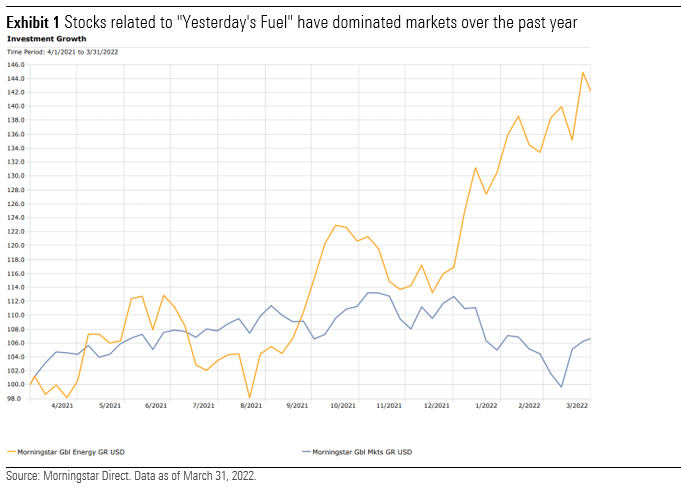
A few years back it was fashionable to say that “Data is the new oil.” In an era of artificial intelligence, robotics, and renewable energy innovation, the fossil fuels that had powered the global economy since the Industrial Revolution seemed passé. The pandemic only amplified these trends.
Fast forward to early 2022, and oil is the new oil. Even before Russia's war on Ukraine wreaked havoc on commodity markets, crude prices had climbed to 2014 levels, stoking generationally high inflation. The energy sector has paced global stock markets. Meanwhile, Morningstar's Equity Research Team expects oil prices to stay elevated through 2023.
As far as equity markets are concerned, Russian tanks rolling into Ukraine have overtaken the Teslas cruising motorways dotted with wind turbines. Leadership has rotated away from the techy innovators to what used to be derided as the "old economy." Of Morningstar's 11 global equity sector indexes, energy has been the best performer for the year that ended with 2022's first quarter.

Though it is certainly possible that the current crisis accelerates the transition to a low-carbon economy, history provides reason for pessimism. According to a New York Times opinion piece: "After previous global energy crises — 1973, 1979, 1990 and 2008 — tensions abated, prices fell, people forgot and governments turned to other priorities. And global dependence on oil and gas kept rising."
There Isn't Just One ESG Response to the Energy Crisis
Sustainable investing has come in for lots of criticism since the start of the war. "Greenwashing" charges have been leveled against sustainable investments that owned Russian assets. Pumping oil and defending Ukraine seem more urgent than concerns around climate change and weapons proliferation. Meanwhile, a rising oil price presents performance challenges for portfolios light on fossil fuels.
Criticism ignores the diversity inherent to ESG. According to Jon Hale, Morningstar's director of sustainability research: "Critics seem to think sustainable investing is dogmatic, monolithic, and undifferentiated. They don't understand that sustainable investing is a big tent, addressing a spectrum of investor concerns and preferences."
To address this spectrum, we used six Morningstar ESG indexes to illuminate the different concerns and preferences. We found three main takeaways.
First, ESG approaches are not mutually exclusive. Sustainable investments can employ both exclusionary screening and positive selection focused on risk mitigation or opportunity.
Second, ESG outcomes vary. Divestment and active engagement, to take two examples, are obviously very different.
Third, the further a sustainable investment deviates from a market portfolio, the more its performance will diverge. A strategy with a few exclusions or one that keeps its regional and sector weights close to the broad market will behave more like a non-ESG equivalent than a more narrowly focused peer. The former may be more of a core holding and the latter a satellite.
Here are our findings in some detail.
First: Excluding Fossil Fuels from a Portfolio - The Consequences Aren't Dramatic
Exclusionary screening is the oldest form of sustainable investing, dating back to when "socially responsible" and "ethical" where common descriptors for strategies. Aligning investments with values is a key motivation. But financial considerations also matter. Combating climate change requires that some fossil fuel reserves will become "stranded assets."
The Morningstar Global ex-Fossil Fuels Index can be examined to better understand the consequences of an exclusionary strategy. The fact is that the energy sector has fallen from more than 11% of global equity market value in 2011 to just 3.5% at the end of 2021. For this reason, the index hasn’t strayed far from the broad market over the past several years. Of course, any deviation from market exposure will cause divergence, which will inevitably be positive in some market conditions and negative in others. In the wake of the Ukraine crisis, the Morningstar Equity Research team updated its near-term forecast for Brent crude prices to roughly $100 per barrel through 2023. Higher oil prices mean more profits for energy companies, raising the fair value of their shares. The question investors must ask is: What is already factored in to stock prices?
The debates around divestment, impact, engagement, and intent will continue, as investors weigh considerations. Fossil fuel divestment will inevitably work for some but not others. The implications of divestment on a portfolio do not appear dramatic.
Second: ESG Risk Mitigation - Effective in Recent Years but Not a Guaranteed Outperformer
To many investors, ESG issues are material financial risks. Environmental impact, labor relations, product safety, data privacy, and business ethics are issues that can impact a firm's results. Business today undoubtedly faces rising expectations to serve a range of stakeholders.
The Morningstar Global Sustainability Index can be examined to better understand the nature of a risk mitigation strategy. The equity index is aligned with the Morningstar Sustainability Rating for funds. Energy and materials are both systemic underweights for the sustainability index. Not only do businesses in extractive industries produce emissions, effluence, and waste, but they also face challenges related to health and safety, community relations, and business ethics, according to Sustainalytics.
How has ESG risk mitigation worked out for the Morningstar Global Sustainability Index? Not bad for the past 5 years. Underweighting the energy sector has contributed to outperformance, but overweighting technology stocks has contributed even more.
Third: Seeking ESG Opportunity - Valuation Can be a Concern
To some investors, ESG is an investment indicator. A company can use sustainability to establish or enhance a competitive advantage. Such companies may or may not be in a business directly related to ESG. But the idea is that a strong ESG profile is a desirable attribute in a company, and investors may practice "positive ESG selection" to target it.
The Morningstar Global Sustainability Leaders Index can be examined to better understand the nature of investment strategies that seek ESG opportunity. With fewer constraints at the sector and regional level, the index has outperformed the broad market by a larger margin than Morningstar Global Sustainability Index over the past 5 years. That said, it underperformed badly in the first quarter of 2022. Total lack of exposure to the soaring energy sector detracted from returns, as did a crash in technology stocks. Whether lack of energy exposure turns out to be a positive or negative long-term is an open question.
Valuation is a real concern for a strategy seeking ESG opportunity. David Meats, Morningstar equity research director for energy and utilities speaks of the cycle of fear and greed driving energy sector performance: "The market is a bit myopic with oil prices; when prices are up it tends to assume they'll stay up, when prices are down; it does the same." The implication is that investors should heed Warren Buffett's maxim to be "greedy when others are fearful and fearful when others are greedy."
For years, the market bid up the shares of stocks that carry low levels of ESG risk. In November 2021, Morningstar research director Haywood Kelly wrote: "[I]nvestors are paying too much for good ESG companies and too little for bad ESG companies."
Fourth: Active Ownership - Indexes Can Facilitate Engagement
Shareholders of public companies can influence their behavior through dialogue with management and the board, voting their proxies, proposing resolutions, even advocating for public policy that addresses sustainability concerns. Indexes don't own securities. But the managers of passive funds allocate assets to index constituents when they replicate a benchmark. Indexes can therefore be used as tools that facilitate active ownership for sustainable investors.
The Morningstar Global EU Climate Transition Benchmark / Morningstar Markets Paris Aligned Benchmark, can be examined to provide insight into active ownership. The climate indexes enable investors to implement their views on climate risk mitigation and climate-related opportunities while channeling investments toward sustainable activities. The indexes devote below-market weight to businesses like Shell, whose commitment to net zero emissions has been questioned, and Volkswagen, whose electric vehicle business lags peers. Meanwhile, companies like Whirlpool, which is taking strides to minimize its carbon impact, and Kone, which builds energy efficient elevators and escalators, are emphasized.
The case of Exxon and activist investor Engine No. 1 gives hope that shareholders can effectuate change from within oil majors. New board members are pushing a climate-focused agenda. Some believe that fossil fuel companies can become renewable leaders, with their vast resources and expertise. It will surprise some to learn that Exxon was an innovator in solar technology in the 1970s. The potential is there, but their contribution to the low-carbon transition remains to be seen.
Fifth: Thematic ESG - Renewable Energy Investing Can be Carbon Intensive and Volatile
According to Morningstar data, thematic investments tripled their market share in the decade ending in 2021, with renewable energy considered a key secular growth driver. Clean energy investors might be motivated by sustainability criteria or pure financial goals.
The Morningstar Global Renewable Energy Index highlights the shares of companies leading the transition to the low-carbon economy. Investors aiming to invest in climate solutions to combat climate change might be surprised by the carbon intensity of some companies involved in renewable energy. In fact, the Morningstar Global Renewable Energy Index is twice as carbon intensive as the broad equity market. Why? Many companies are involved in both fossil fuels and renewables. Also, a company’s products and services can be climate-friendly, but have carbon intensive operations.
From an investment perspective, thematic investments like renewables can be very volatile. A portfolio of stocks, concentrated by industry and sector, many of them highly correlated with each other, will bounce around more than a diversified one. Unsurprisingly, the Morningstar Global Renewable Energy Index's standard deviation of returns (a measure of volatility) has exceeded that of the broad market.
Even long-term secular growth drivers can experience setbacks. Danish power group Orsted, which had been a strong performing darling of renewable energy investments, and Vestas, a wind turbine maker, both suffered significant share price decline in 2021. Low wind speeds and higher renewable costs were to blame.
Only time will tell how the current energy crisis, exacerbated by the war in Europe, changes the field. Will it undermine the growth of ESG or accelerate it? Will it favor one of the current sustainable investing approaches over others? Could it give rise to new expressions of ESG? For now, it’s critical to realize that sustainable investing is diverse in its motivations and its applications.




















